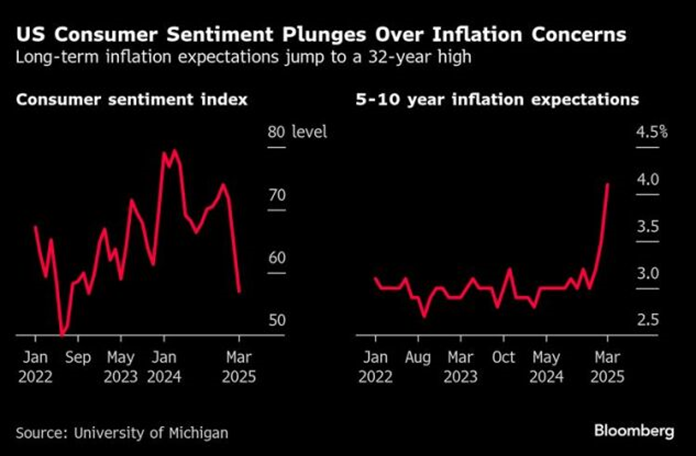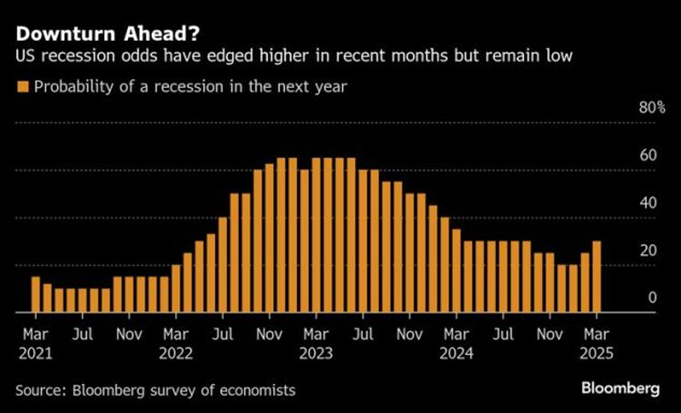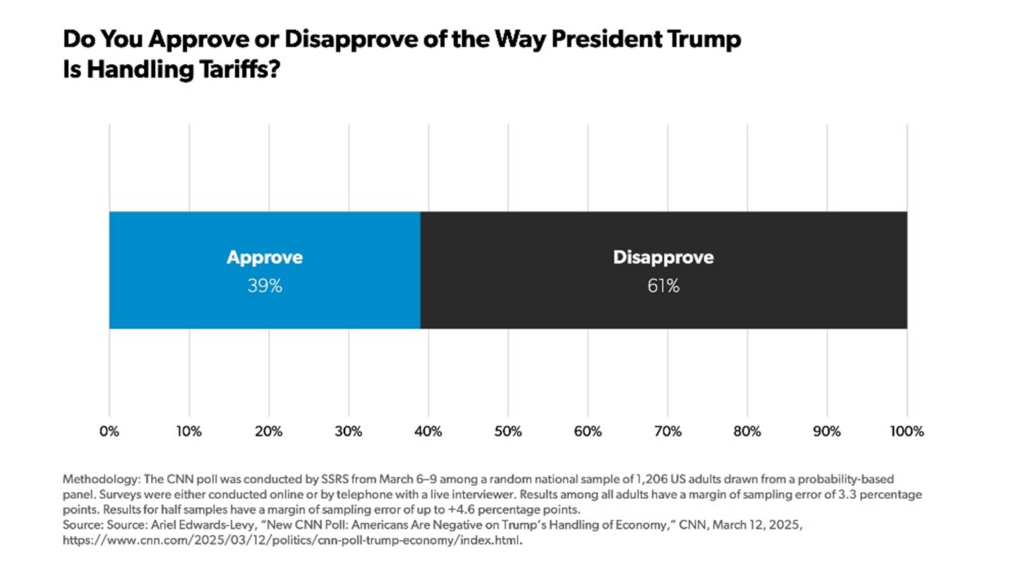Thought of the Week:
The morning of what President Trump referred to as “Liberation Day,” I found myself sitting at a conference room table across from a member of Congress and his Chief of Staff. The meeting had been scheduled several weeks prior as way to provide businesses with a progress report on the status of the reconciliation bill, tax policy, and deregulation. Since then, tariff policy had become the rage in Washington, and while I and the other corporate lobbyists assembled expressed our concerns about the president’s upcoming announcement, the Congressman said that although he did not believe Congress had delivered the appropriate amount of pushback, no one should be surprised that this day had arrived as tariffs were an integral part of the president’s election campaign. Openly admitting, that he had no idea what was coming later that day, he explained that even though he personally believed tariffs were a tax, they could also be used as leverage to address bad trade actors. In responding to questions, the Congressman acknowledged that it might have been better to use the USMCA as a model to open other markets, that tariffs would hurt American farmers in his district, and that it was likely that business uncertainty would continue to persist even after the announcement. In addition, he confirmed that Republican lawmakers had given the president such a long runway on trade thus far simply because his poll number remained high, and the party had just won two special elections. In a side conversation, while staff told me that the tariff announcement would include certain carveouts and exclusions, the Congressman was adamant that White House tariff policy would not change until an appropriate amount of political and market pressure was applied. Although I don’t believe we’ve reached that tipping point yet, there seems to be some blood in the water. Consider that just hours after President Trump’s Rose Garden announcement four Republicans joined with Senate Democrats to advance a resolution that would terminate the White House’s national emergency declaration used to impose tariffs on Canadian goods. What’s more, two Senate Finance Committee members just introduced a bill aimed at limiting presidential tariff authority and boosting congressional oversight of trade policy. Dubbed the “Trade Review Act of 2025,” the bill would require congressional approval of any new or increased tariffs proposed by the president, excluding trade remedies. The lawmakers argue that such legislation is needed to restore Congress’ constitutional authority over tariffs and trade policy. In fact, the Constitution gives Congress, not presidents, the authority to “lay and collect Taxes, Duties, Imposts, and Excises,” as well as “regulation of Commerce with foreign nations.” Because President Trump’s tariffs lack such Constitutional legitimacy, should his program stick, it may further weaken the separation of powers, usurp authority, and substitute rule by Executive Order for authentic law. Congress has the power it needs to defend its authority, and should use it. If Congress likes President Trump’s tariffs, it should impose them; it not, it should end them.
Thought Leadership from our Consultants, Think Tanks, and Trade Associations
Bloomberg Government Features a Positive Take on the Trump Tariffs. According to Mitsubishi UFJ Morgan Stanley Securities, President Trump’s economic policies will ultimately result in a stronger dollar, rising stock prices, and stable Treasury yields. In fact, the Trump administration appears well aware that prolonged reciprocal tariffs will lead to stagflation, and for this reason, the president has no intention of leaving the stock market down. Tariff policies are likely to be revised after the White House extracts as many concessions as possible from U.S. trading partners. While tariff-related risks will end as early as this summer, a deterioration in consumer and business sentiment caused by the imposition of tariffs is likely to cause a short-term downturn in the economy. At the same time, the impact of reciprocal tariffs on inflation will not be immediately apparent and will take time to manifest. As such, the probability of the Fed cutting interest rates by 25bps three times this year has increased.
Eurasia Group Says Elevated Policy Uncertainty Will Continue Even After the Tariff Announcement. The first quarter of 2025 saw markets dominated by shifting assessments of the Trump administration’s policies, their impact on the outlook for the U.S. economy, and on their geopolitical and geo-economic spillovers. Increasingly, markets are acknowledging the stagflationary domestic impact of the U.S. policy mix, and the structural damage to global trade and finance—U.S. asset price moves are consistent with this elevated cyclical and policy uncertainty; markets are pricing 2-3 cuts this the year from the Fed (close to an additional cut compared to the beginning of the year); and the dollar has weakened 2.1%. The impact of political uncertainty is visible well beyond core markets—auto stocks have declined sharply; copper prices continue to surge on tariff-related hoarding and related price arbitrage; and gold has risen more than 17% in Q1. Importantly for the near-term outlook, the administration’s volatile policy approach has created fundamental and lasting policy uncertainty, not just about the U.S. policy outlook but also about the responses from allies and trade partners. Elevated policy uncertainty is likely to be a lasting feature. Although this week’s tariff announcements have resolved uncertainty about the U.S.’s initial steps on tariffs, trade partners responses will evolve over the coming weeks. And the implementation of reciprocal tariffs will not be the endpoint for the administration’s transformation of financial and economic policy. What’s more, despite declines in U.S. yields and the dollar, at current levels both are likely to conflict with the administration’s objective of improving trade imbalances and driving reindustrialization.
Observatory Group Reviews President Trump’s Reciprocal Tariff Policy. Earlier this week, President Trump announced his reciprocal tariff policy during a Rose Garden speech—the fact sheet can be found here; the complete Executive Order (EO) here; and the annex of countries receiving the reciprocal rates here. The White House’s tariff announcement was a brutal 1-2 punch to global trade—covering all countries with material rates, while explicitly promising even worse outcomes for countries that retaliate. There are two core elements to the new reciprocal tariff policy:
- A universal baseline tariff of 10% applied to imports from all countries; Customs and Border Protection (CBP) will begin collecting this tariff on April 5th; and
- A country-specific reciprocal tariff for approximately 60 countries with over a 10% trade deficit with the U.S., including non-tariff barriers. This list includes some of the U.S.’s largest trading partners, with rates going as high as 50%. CBP will begin collecting these tariffs on April 9th.
While the administration did not detail the calculations it used, this will not be integral to any final negotiated outcome since any tariff reductions will be based as much on the President’s preferences as the initial rate. One surprise was that the president exempted Section 232 products from the universal and reciprocal tariffs and did not announce any new Section 232 investigations (he also exempted gold bullion and energy and minerals that are not available for mining in the U.S.). The president’s announcement confirmed the view that the nationalists in the White House are dominating trade policy. In the end, the tariffs targeted more countries than the so-called “dirty 15”—with nearly all countries making the list. In setting a universal flat rate for all countries, along with reciprocal rates on dozens of U.S. trading partners, rates could come down via negotiations, including national security elements, but they could also rise depending on how the target country reacts and if they impose retaliatory tariffs. Retaliation could lead the administration to impose what his team has calculated as the “true” reciprocal tariff—essentially double the announced tariff they chose to impose.
“Inside Baseball”
The White House Correspondents’ Association (WHCA) is Coordinating a Response to Changes to the White House Press Room’s Seating Plan. Members of the WHCA, including its leaders and a number of White House bureau chiefs, are considering a “sit-in”-style protest, where reporters would hang onto their old seats and refuse to leave them, to protest the White House Briefing Room’s new seating plan. Several journalists say the new seating arrangement, which the White House says is “based on metrics more reflective of how media is consumed today,” is the administration’s latest effort to control press access to the president, and favor friendlier reporters over wire services like the AP. The goal, the WHCA says, is to make it easier to exact punishment on specific outlets over their coverage.
In Other Words
“In the face of unrelenting economic warfare, the United States can no longer continue with the policy of unilateral economic surrender,” President Trump announcing reciprocal tariffs on April 2.
Did You Know
This week, Sen. Booker (D-NJ) set the record (25 hours and 5 minutes) for the longest continuous Senate floor speech in history, surpassing Sen. Thurmond’s (R-SC) former record of 24 hours and 18 minutes. While Booker gave his speech in protest of Trump administration policy, Thurmond delivered his speech as part of a filibuster to block the Civil Rights Act.
Graphs of the Week
With Anxiety Over Tariffs Building, U.S. Consumer Sentiment Tumbled last month to a more than two-year low, from 64.7 to 57, and long-term inflation expectations jumped to a 32-year high.

Most Economists Don’t Anticipate a Recession within the next year, but they do say the chance of an economic contraction has increased. Another worry among economists is the risk that a slowdown in growth will occur alongside accelerating inflation, a scenario known as stagflation.

60% of Americans Disapprove of President Trump’s Handling of Tariffs. According to the American Enterprise Institute (AEI), tariffs are the Trump policy voters support least, but other areas of the Trump agenda also face significant disapproval—56% disapprove of his handling of the economy; 52% disapprove of his management of the federal budget; and 51% disapprove of his management of the federal government. Looking to the 2026 midterm elections, such strains suggest that any economic damage could lower the president’s approval rating. If members of Congress become concerned about losing their seats, they might be emboldened to push back, with business leaders and voters following.
